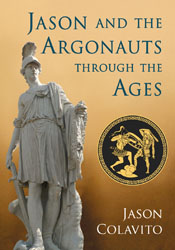OVERVIEW OF THE BOOK

Jason and the Argonauts through the Ages
By Jason Colavito
Most people who have seen the 1963 movie think they know the story of Jason and the Argonauts: the Golden Fleece, the voyage of the Argo, the clashing rocks, the Harpies, the dragon, Medea. But they only know part of the story.
For more almost three thousand years the Jason story has been told and retold, surviving longer than any other epic of Ancient Greece—longer than the Odyssey and the Iliad, and nearly as long as the stories of the Olympian Gods themselves. But the story grew and changed over time in a dramatic fashion. The epic history of this myth contains an intellectual and religious history of more than a thousand years of Mycenaean and Greek ideas about life, the gods, and man’s place in the world and the cosmos, taking us on a grand adventure from the archaeology of Mycenaean Greece to the necromantic rites of the Hittite empire, to the earliest Near East philosophies about life after death.
Despite standing at the center of Greek myth, there has never been a modern full-length English language book exploring the hero Jason despite the publishing attention afforded such relatively secondary mythic figures as Medea and Helen of Troy, who even received a lavish recent BBC/PBS documentary. It’s time to rehabilitate Jason and the Argonauts.
Jason and the Argonauts through the Ages explores one of humanity’s earliest epics in an archaeological, cultural, artistic, historic, and literary context. My book draws on two decades of exciting new scholarship, synthesizing developments in archaeology, literary theory, Classical Studies, linguistics, comparative mythology, and more that have never before been brought together to form a multidisciplinary yet entertaining study of the origins, development, and meaning of Jason. It provides new insight into the Jason myth using the latest interdisciplinary research:
Beginning with the origins of Greek mythology and an overview of the archaeology of the Mycenaean Greek world in which the legend arose c. 1500 BCE, I trace the development of the Jason story down to today, including Jason’s transition from godlike hero to fully-developed and vulnerable human. On this adventure readers will learn:
By the end of the book, readers will have a new appreciation for one of Greek mythology’s most ancient and least understood epics and will have seen the many ways a single story can be retold to reflect the values and needs of changing societies—in short, why Jason is relevant and why Jason matters.
By Jason Colavito
Most people who have seen the 1963 movie think they know the story of Jason and the Argonauts: the Golden Fleece, the voyage of the Argo, the clashing rocks, the Harpies, the dragon, Medea. But they only know part of the story.
For more almost three thousand years the Jason story has been told and retold, surviving longer than any other epic of Ancient Greece—longer than the Odyssey and the Iliad, and nearly as long as the stories of the Olympian Gods themselves. But the story grew and changed over time in a dramatic fashion. The epic history of this myth contains an intellectual and religious history of more than a thousand years of Mycenaean and Greek ideas about life, the gods, and man’s place in the world and the cosmos, taking us on a grand adventure from the archaeology of Mycenaean Greece to the necromantic rites of the Hittite empire, to the earliest Near East philosophies about life after death.
Despite standing at the center of Greek myth, there has never been a modern full-length English language book exploring the hero Jason despite the publishing attention afforded such relatively secondary mythic figures as Medea and Helen of Troy, who even received a lavish recent BBC/PBS documentary. It’s time to rehabilitate Jason and the Argonauts.
Jason and the Argonauts through the Ages explores one of humanity’s earliest epics in an archaeological, cultural, artistic, historic, and literary context. My book draws on two decades of exciting new scholarship, synthesizing developments in archaeology, literary theory, Classical Studies, linguistics, comparative mythology, and more that have never before been brought together to form a multidisciplinary yet entertaining study of the origins, development, and meaning of Jason. It provides new insight into the Jason myth using the latest interdisciplinary research:
- Jason was originally a Mycenaean healing god who died and was resurrected each year in service to an all-powerful pre-Greek earth goddess
- Jason’s voyage to Colchis was originally a trip to the Underworld
- The Golden Fleece originated in the golden costumes created in the Near East to adorn the statues of the gods
- The Jason myth was purposely rewritten in the Archaic period to reflect the transition from Hera to Zeus worship and the changing Greek beliefs about heroes and gods
Beginning with the origins of Greek mythology and an overview of the archaeology of the Mycenaean Greek world in which the legend arose c. 1500 BCE, I trace the development of the Jason story down to today, including Jason’s transition from godlike hero to fully-developed and vulnerable human. On this adventure readers will learn:
- Archaic Greeks purposely censored the most controversial “lost” elements
- Medieval scholars thought Jason was “really” Jesus
- Early modern alchemists thought Jason could teach them how to turn lead into gold
- Modern writers have proposed explanations ranging from icebergs to extraterrestrials to account for the Jason myth
By the end of the book, readers will have a new appreciation for one of Greek mythology’s most ancient and least understood epics and will have seen the many ways a single story can be retold to reflect the values and needs of changing societies—in short, why Jason is relevant and why Jason matters.


